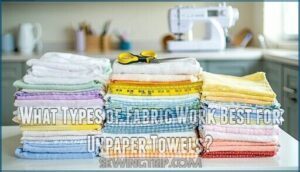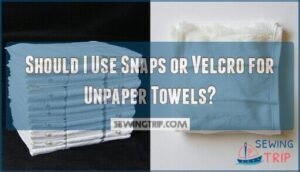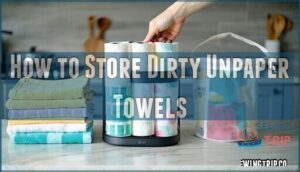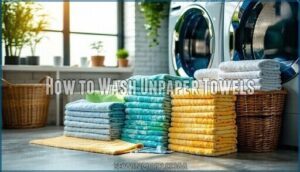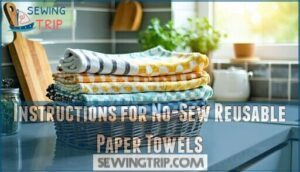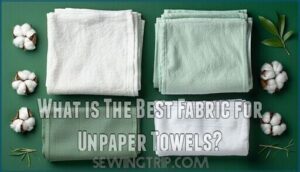This site is supported by our readers. We may earn a commission, at no cost to you, if you purchase through links.
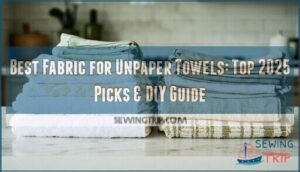 The best fabric for unpaper towels combines high absorbency with durability through countless wash cycles.
The best fabric for unpaper towels combines high absorbency with durability through countless wash cycles.
Cotton terry cloth tops the list because it soaks up spills like a champ and gets softer with each wash. Bamboo fabric offers natural antimicrobial properties, while linen provides excellent absorption for heavy-duty cleanup jobs.
You’ll want to skip synthetic blends since they repel water rather than absorb it. Old cotton t-shirts and flannel receiving blankets work surprisingly well for DIY projects.
Natural fibers are your friends here—they become more absorbent over time, unlike their synthetic counterparts. The right fabric choice can make all the difference in your cleaning routine.
Table Of Contents
- Key Takeaways
- What Are Unpaper Towels?
- Do Unpaper Towels Save Money?
- Supplies to Make Unpaper Towels
- What Types of Fabric Work Best for Unpaper Towels?
- Should I Use Snaps or Velcro for Unpaper Towels?
- How to Sew Unpaper Towels
- How to Store Dirty Unpaper Towels
- How to Wash Unpaper Towels
- Instructions for No-Sew Reusable Paper Towels
- What is The Best Fabric for Unpaper Towels?
- Frequently Asked Questions (FAQs)
- Conclusion
Key Takeaways
- You’ll get the best results with cotton terry cloth – it offers superior absorbency and becomes softer with each wash cycle, making it the top choice for reusable cleaning cloths.
- Natural fibers beat synthetic materials every time – cotton, bamboo, and linen absorb liquids effectively, while synthetic blends repel water, making them useless for cleanup tasks.
- You can save serious money by switching – unpaper towels cost $10-30 upfront but replace $156 worth of paper towels annually, paying for themselves within 3-4 months.
- Bamboo fabric gives you extra benefits – it’s 40% more absorbent than paper towels and naturally fights bacteria, making it perfect for kitchen cleaning tasks.
What Are Unpaper Towels?
Unpaper towels are reusable fabric alternatives that replace disposable paper towels in your kitchen and around the house.
These absorbent fabric towels offer impressive fabric absorbency rates while supporting eco-friendly cleaning practices. You’ll find unpaper towel uses extend beyond spills – they work for wiping counters, drying hands, and cleaning windows.
The best unpaper towel material typically includes cotton, flannel, or terry cloth that can handle multiple wash cycles. This sustainable household swap eliminates thousands of paper towels annually, making your zero waste kitchen both practical and environmentally responsible while maintaining excellent cleaning performance.
Consider upcycling old fabrics into these useful alternatives.
Do Unpaper Towels Save Money?
Your wallet will thank you for switching to reusable paper towels. The average household spends $156 annually on disposable paper towels, but unpaper towels require only a small initial investment of $10-30 for a complete set. That’s serious cost savings right there.
Your wallet will celebrate this eco-friendly switch – from $156 yearly waste to a one-time $20 investment that pays for itself in months.
Here’s how the math breaks down for paper towel alternatives:
- Initial investment – One-time purchase of $12-20 for quality fabric
- Usage frequency – Same convenience as disposables, unlimited reuses
- Long-term savings – Break-even point reached within 3-4 months
- Brand comparison – DIY vs. buy options both cost less than continuous paper towel purchases
- Fabric absorbency – Superior performance means you’ll use fewer towels per mess
The beauty lies in reusing your fabric over and over. Many people are switching to Swedish dish cloths, which are compostable and quick-drying. Each unpaper towel set lasts 2-3 years with proper care, eliminating those weekly shopping trips for paper towels and saving you hundreds annually.
Supplies to Make Unpaper Towels
Now that you understand the financial benefits, let’s gather what you’ll need to start crafting. Your basic supply list includes fabric scissors for clean cuts, a sewing machine for efficient construction, and measuring tools like rulers or cutting mats.
You’ll want durable, absorbent cotton fabric as your primary material. Thread types should match your fabric weight—cotton thread works well with cotton fabrics. Pattern weights help keep fabric steady during cutting.
Don’t forget a rotary cutter for precise edges and pins for holding pieces together before sewing. Switching to cloth can help reduce deforestation concerns associated with paper towels, which is a significant environmental benefit.
What Types of Fabric Work Best for Unpaper Towels?
Which fabrics deliver the best performance for your homemade cleaning cloths? The right material makes all the difference in creating effective reusable towels.
- Cotton flannel – Soft, absorbent, and becomes more durable with each wash
- Terrycloth – Features looped pile texture that traps liquid exceptionally well
- Bamboo fabric – Offers superior absorbency comparison to cotton while providing antimicrobial benefits
- Microfiber blends – Lightweight yet highly effective for quick cleanup tasks
Skip quilting cottons and water-repellent materials. For example, Supima cotton towels offer exceptional softness.
Test fabric durability and texture preferences before sewing to confirm your unpaper towels handle spills effectively.
Should I Use Snaps or Velcro for Unpaper Towels?
When choosing between snaps and Velcro for your reusable paper towels, consider what matters most: convenience or longevity. Snaps offer superior snap durability, withstanding hundreds of wash cycles without losing their grip.
They won’t catch lint during washing and maintain a clean appearance over time. However, you’ll need special tools for installation, which adds to your initial cost comparison.
Velcro provides unmatched attachment ease – just press and go. It’s familiar and requires no special sewing skills for DIY projects. The downside? Velcro strength diminishes over time as hook-and-loop fibers wear down.
It also collects lint and debris, making your unpaper towels look shabby faster. For a stronger hold, consider sewing the velcro for extra reinforcement. It also collects lint and debris, making your unpaper towels look shabby faster.
Your aesthetic preference plays a role too. Snaps create a professional look, while Velcro offers quick functionality. For fabric choices and long-term durability, snaps win. For convenience and beginner-friendly sewing projects, Velcro takes the lead.
How to Sew Unpaper Towels
Now that you’ve decided on fastening options, creating your own unpaper towels becomes straightforward with proper sewing techniques. Start by cutting fabric squares with precise 1/4-inch seam allowances for professional results.
Layer your absorbency layers—place terry cloth and flannel with right sides together, then secure with pins. Use a straight stitch around the perimeter, leaving a 2-3 inch opening for turning.
Different stitch types work well, but consistency matters most. After sewing, trim corners to reduce bulk and turn right-side out through the opening.
For edge finishing, topstitch around the entire towel to create reinforced seams. This technique works across various pattern variations:
- Single-layer cotton squares for light cleaning tasks
- Double-layer terry cloth combinations for heavy-duty absorption
- Mixed fabric blends for versatile household use
Your DIY reusable towels are now ready for washing before first use. For slippery fabrics, consider using muslin for stability during the cutting process.
How to Store Dirty Unpaper Towels
After crafting your unpaper towels, proper storage keeps your kitchen organized and hygienic. A dedicated wet bag storage system controls odors and prevents moisture from spreading to clean towels.
These waterproof containers come in zippered, drawstring, or hook-and-loop styles to match your preferences. Separate kitchen wipes from cleaning wipes to prevent cross-contamination between food prep areas and bathroom surfaces.
Choose darker-colored containers to hide stains while maintaining a clean appearance. Replace or wash your storage container weekly to maintain freshness. To avoid fabric deterioration, consider acid-free storage options.
Smart storage solutions for reusable paper towels include:
- Countertop containers with tight-fitting lids for immediate access
- Mesh laundry bags hung inside cabinets for ventilation
- Pail liners that fit standard waste baskets
- Shower caddies mounted on walls for space-saving storage
- Small buckets with handles for easy transport to washing areas.
This organization supports effective waste reduction while maintaining proper stain prevention and odor control before your regular washing frequency.
How to Wash Unpaper Towels
Washing your unpaper towels properly keeps them fresh and absorbent for years.
Start by pre-treating stains with baking soda or enzymatic cleaners before tossing them in the machine wash. Use warm water and a gentle cycle with mild detergent for best results.
Here’s your simple laundry routine:
- Sort by fabric type – Cotton towels can handle higher temperatures than delicate bamboo blends
- Skip fabric softeners completely – They coat fibers and reduce absorbency by up to 30%
- Choose air drying when possible – Heat from the dryer can break down natural fibers over time
For stain removal and odor control, add white vinegar to your wash cycle occasionally. This natural solution brightens colors and eliminates lingering smells without harsh chemicals. For best results, consider mild detergent options for your unpaper towels.
Instructions for No-Sew Reusable Paper Towels
Anyone can master these nosew unpaper towels without threading a needle. Start by cutting your absorbent fabric into 10-inch squares using a cutting mat for precision. Cotton flannel or terry cloth work brilliantly for reusable paper towels.
For fray prevention tips, apply fabric glue options along raw edges or use iron-on hemming tape as hemming alternatives. Simply fold each edge inward by half an inch, then press with a hot iron to seal.
Quick assembly methods involve layering two fabric squares together with hemming tape between them. Press firmly to bond the layers, creating sturdy two-ply towels. Stack your finished unpaper towels in a decorative basket for easy access. These can be made using simple knotting techniques for a unique touch.
These fabric alternatives beat disposable towels every time. You’ll save money while reducing waste, and your kitchen counter will thank you for the eco-friendly upgrade.
What is The Best Fabric for Unpaper Towels?
After testing dozens of fabric options, cotton emerges as the clear winner for unpaper towels. You’ll find that 100% cotton flannel offers the perfect balance of absorbency and durability, soaking up spills like a champ while lasting through hundreds of wash cycles.
Bamboo fabric runs a close second, providing 40% higher absorbency than traditional paper towels plus natural antibacterial properties. For absorbency comparison, cotton absorbs 80-90% of liquids, while microfiber wicks moisture quickly but doesn’t hold as much.
Terry cloth’s looped texture traps dirt effectively, making it ideal for heavy-duty cleaning tasks. Some prefer Supima cotton’s softness for its luxurious feel and durability.
Cost analysis shows cotton flannel provides the best value – it’s affordable upfront and maintains performance longer than cheaper alternatives. Texture preferences matter too; flannel feels soft against surfaces, preventing scratches on delicate items. The environmental impact of choosing durable, natural fibers over synthetic options makes cotton the sustainable choice.
Frequently Asked Questions (FAQs)
What is the best fabric to use for UNpaper towels?
Like choosing parchment for scribes of old, you’ll want cotton flannel or bamboo fabric for your unpaper towels.
They’re highly absorbent, soften with washing, and won’t scratch surfaces while cleaning effectively.
What are UNpaper towels made of?
Unpaper towels are typically made from absorbent natural fibers like cotton, bamboo, linen, or hemp.
You’ll find flannel and terry cloth are popular choices because they’re soft, durable, and get better with washing.
How many yards do I need to make UNpaper towels?
Picture stacks of soft fabric squares replacing endless paper towel rolls in your kitchen.
You’ll need just one yard of fabric to create twelve standard 8×8-inch unpaper towels that’ll serve your family for years.
What is the best fabric for sewing dish towels?
Cotton flannel works best for dish towels because it’s absorbent, soft, and gets better with each wash.
You’ll love how terry cloth soaks up spills, while bamboo fabric offers eco-friendly antibacterial properties.
How long do unpaper towels typically last?
High-quality cotton unpaper towels typically last 2-5 years with proper care, withstanding 100-200 wash cycles. Bamboo blends increase durability by 25%, while reinforced edges prevent fraying and extend their lifespan substantially.
Can unpaper towels replace all paper towels?
Sarah’s kitchen makeover included ditching paper towels entirely, but she quickly learned some limitations.
You’ll replace most paper towels successfully, though greasy messes and pet accidents might still need disposables for hygiene reasons, which can be considered hygiene reasons.
Are unpaper towels sanitary for food prep?
Yes, unpaper towels are sanitary for food prep when you maintain proper hygiene.
Wash them after each use with hot water and detergent.
Keep separate towels for raw meat and vegetables to prevent cross-contamination.
What size should unpaper towels be made?
Make your unpaper towels 10-12 inches square for versatility. You’ll handle most spills comfortably while keeping them manageable for washing and storage.
Smaller 8-inch squares work well for quick cleanups and napkin replacements.
Do unpaper towels work for greasy messes?
Grease cuts through some fabrics like butter, but you’ll need the right material.
Cotton and bamboo unpaper towels handle greasy messes well, though they require hot water washing and degreasing dish soap for proper cleaning.
Conclusion
Households using reusable towels reduce paper towel consumption by 84% annually, translating to significant savings.
Cotton terry cloth remains the best fabric for unpaper towels due to its superior absorbency and durability.
Bamboo offers antimicrobial benefits, while linen handles tough spills effectively.
You’ll find natural fibers outperform synthetics consistently, becoming more absorbent with each wash cycle, and choosing the right fabric guarantees your unpaper towels perform reliably for years.
- https://en.wikipedia.org/wiki/Terrycloth
- https://www.nytimes.com/2023/06/23/us/roe-v-wade-abortion-views.html
- https://squareup.com/help/us/en/article/5068-what-are-square-s-fees
- https://growmyearth.com/best-fabric-for-reusable-paper-towels/
- https://ecoboo.net/blogs/green-clean/10-best-reusable-paper-towels?srsltid=AfmBOoqazzbXausHG1Bae2U-JlJ3W1NmDyeNkgV9AAIChF-8VKD_N64e


